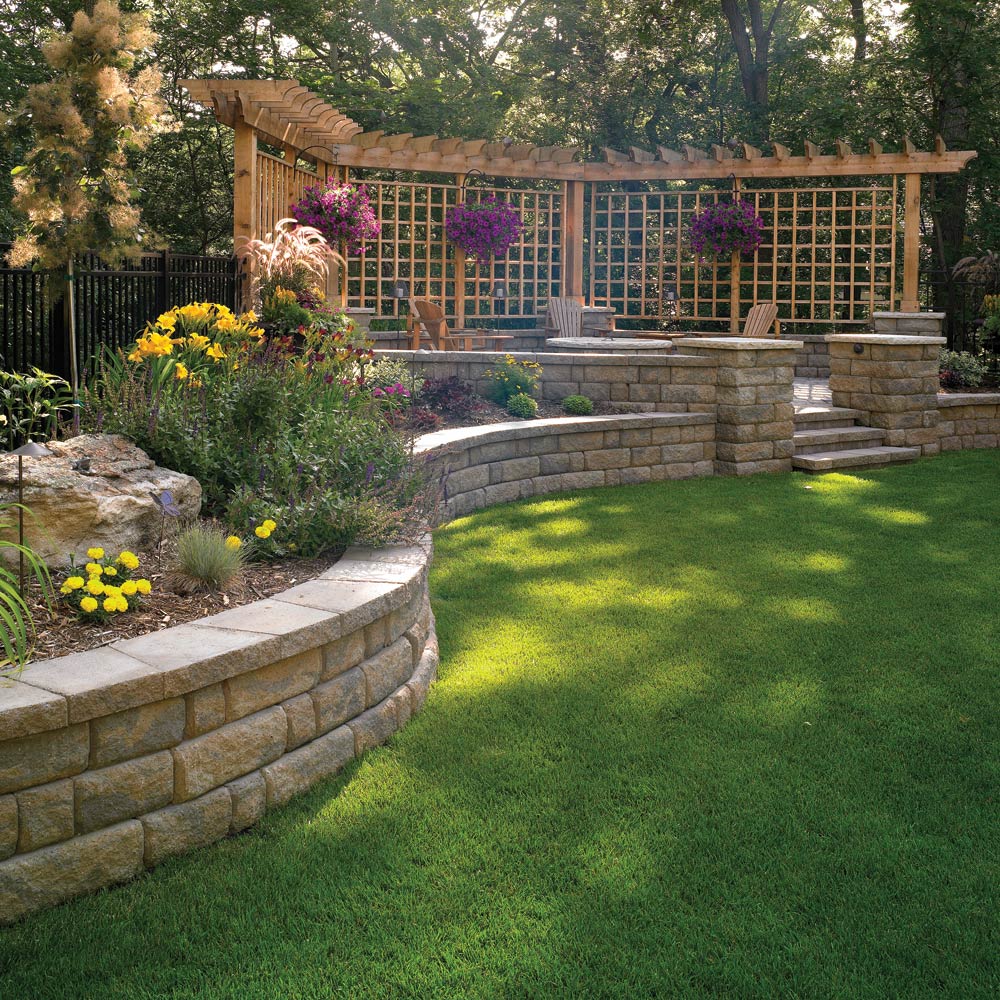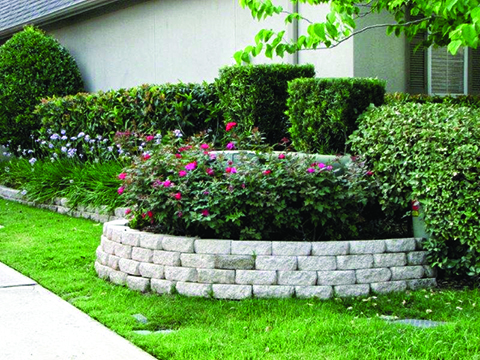Have you ever envisioned building a retaining wall in your garden? For those who are unsure of how to go about it, here are some steps that will point you in the right direction.
A retaining wall is a field stone wall that prevents soil erosion, or a wooden or stone structure built along the outside of a garden to keep the soil in place.
How to build a retaining wall for a garden
A retaining wall is a great way to add an attractive visual element to your garden or yard. A well-built garden wall can also be functional, helping to create level spaces and prevent erosion.
Wooden retaining walls are often used in gardens because they can be built in any shape, size and color. They’re also relatively easy to install and cost less than other types of retaining walls.
Stone and brick are also popular materials for garden walls because they’re durable and aesthetically pleasing. Before choosing a material for your retaining wall, though, consider the following:
What will the wall be used for? If you want the retaining wall to keep soil in place or prevent erosion, choose a sturdy material that won’t break down over time. If your goal is simply to add style to your yard, you can use any type of stone or brick that suits your taste best.
How much work do you want to put into building the wall? Stone and brick are heavier than wood and require more labor on your part than a wooden retaining wall would take. Stone is also more expensive than wood when it comes to buying materials for construction.
A retaining wall is a structure built to resist the lateral pressure of soil, sand, or gravel that might otherwise move or deform a structure. Retaining walls are usually made of masonry materials such as brick, block, concrete and stone. They are generally built on sloping ground to prevent soil erosion, but they may be built on level ground in special cases where soil erosion is a concern.
Retaining walls can also be used to hold back water from flowing downhill. These types of retaining walls are called floodwalls.
Types of retaining walls
There are several different types of retaining walls:
Stone wall: A stone wall is made from the same materials as any other stone wall, but it may be made with larger stones and more mortar than other types. It’s typically used for garden walls or walkways. Stone walls can be built with either flat stones or curved shapes to make them more attractive.

Wooden retaining wall: A wooden retaining wall uses lumber instead of stone or concrete blocks. The lumber may be stained or painted to match your landscaping needs and style preferences. Wooden retaining walls can also be faced with stucco or natural siding materials like cedar or pine boards for added appeal.
A garden retaining wall is a structure that is built to hold back the soil in a garden. It is usually made from concrete or stone, but wood can also be used. A garden retaining wall can be built to any size and shape, but it is best to make it as close to the natural contour of the land as possible to avoid damage to your plants and flowers when the soil settles behind it.
Options for Garden Retaining Walls
There are many different types of retaining walls available, including:
Concrete block walls – A concrete block wall is one of the most popular types of garden walls because they are easy to construct and can be built in any shape or size. Concrete blocks are stacked on top of each other with reinforcing steel bars in between them. If you plan on building a tall wall, you should use reinforced concrete blocks so they will not collapse under their own weight or from pressure from rainwater runoff.
Stone walls – Stone walls are becoming less common due to the cost involved in building them and the time it takes for construction. Stone may also be difficult for some people to work with because it requires specialized tools such as diamond-tipped drill bits and jackhammers that must be rented out by specialty companies.
A retaining wall is a structure that holds back earth, fills the space between two sloping surfaces and supports a walkway or terrace.
There are two main types of garden retaining wall: structural and decorative. Structural walls are made from stone or brick and serve to provide stability and support for other structures in the garden, such as paths and patios. Decorative walls are built purely for visual effect, with no supporting function.
The most common type of garden retaining wall is made from bricks or stones, but you can also use concrete blocks or timber planks. The key thing is to choose a material that matches your style of gardening and fits in with the overall look of your garden.
A retaining wall is a structure built to resist the lateral pressure of soil. A retaining wall can be made from many different materials, but most are constructed using masonry, concrete or stacked stone. Retaining walls are used for a variety of reasons including installing new landscaping and preventing erosion on sloped properties.
Retaining walls should be installed by a professional contractor with experience in building retaining walls. These professionals will have all the necessary tools and equipment needed to build your retaining wall properly and safely.
Costs: Retaining walls are not inexpensive to install, but they can pay off in the long run if they prevent problems with erosion and make maintenance easier on your landscaping. When choosing your contractor, ask about their experience installing retaining walls so you know they know what they’re doing.
Materials: Stone, wood or concrete all work well for building a retaining wall. Wood is typically used when building a small retaining wall that isn’t meant to hold back too much weight or support heavy equipment such as tractors or other heavy machinery. Stone is used more often on larger projects because it is more durable than wood, but it does require more maintenance over time as stones may crack over time due to weathering or other factors (such as being hit by vehicles). Concrete
A wooden retaining wall for a garden is the best choice for people who want to create a natural look for their garden. It is not only a beautiful but also a durable material that will last for many years. If you want to build your own wooden retaining wall, there are some things you should know.
Here are some tips on how to build a wooden retaining wall:
Choose the right place
The first thing you need to do is choosing the right place for your retaining wall. Make sure that it has enough space and can hold all of your plants. If possible, choose a sunny spot so that your plants will get enough sunlight throughout the day.
Prepare the soil
After choosing the right place for your retaining wall, prepare the soil by removing any weeds or rocks from it. You also need to add some compost or manure to give nutrients to your plants.
Digging holes
Digging holes is the next step after preparing the soil. Each hole must be about 1 foot deep and 4 inches in diameter so that it will not crack when you put pressure on it later on. Make sure that every hole is filled with concrete at least halfway down into its depth before building another one next to it so that they
Wooden retaining wall for a garden

A wooden retaining wall is one of the most cost-effective ways to create a garden feature. This type of garden wall can be built from pressure-treated timber or untreated softwood and can be fitted with an optional wooden gate.
Wooden retaining walls can be used for many different types of projects such as:
Garden walls
Fencing
Patios and patio surrounds
Retaining walls are one of the most common landscape features. They can be used to create level spaces and to hold back soil that would otherwise wash away.
Wooden retaining walls are a great choice for garden beds, but they can also be used in other areas of your yard or garden. A wooden retaining wall can add a lot of character and charm to an otherwise plain area.
Wooden retaining wall blocks are easy to install and can be used on any level surface. They provide the same benefits as traditional concrete block retaining walls without all the hassle of mixing concrete and laying block.
These blocks come in several sizes, including 3x3x8, 4x4x8 and 6x6x8 inches. You can also purchase corner blocks for corners where two walls meet up together at an angle or corner caps for finishing off the tops of your walls.
A retaining wall is a structure built to retain soil, rock and/or water. The earliest examples of this were dikes and earth embankments used to keep water in the Nile irrigated land.
Wooden retaining walls are constructed using treated wood or pressure-treated wood (PTW) posts and treated wood boards. These posts are driven into the ground at regular intervals, with the boards nailed between them. Wood is considered one of the most durable materials for retaining walls as it can last for up to 50 years or more if installed properly.
The major benefit of wooden retaining walls is their ability to blend into a garden environment. They are also very cost effective compared with concrete or stone options. However, they do require regular maintenance such as painting or staining (for long term protection).
A retaining wall is a structure built to support the earth around the excavation of a basement or the installation of a septic system.
A retaining wall can be made from various materials, including concrete, stone and wood. The material you choose depends on your budget and personal preference.
Concrete retaining walls are inexpensive and easy to install, but they require regular maintenance and repairs over time. Concrete walls also tend to crack if struck by vehicles or other heavy objects.
Stone walls are more expensive than concrete ones but last much longer without needing repairs. They also look more attractive than concrete walls do, especially when well-maintained.